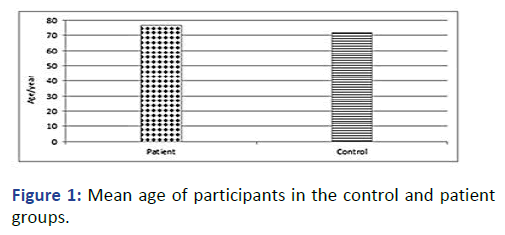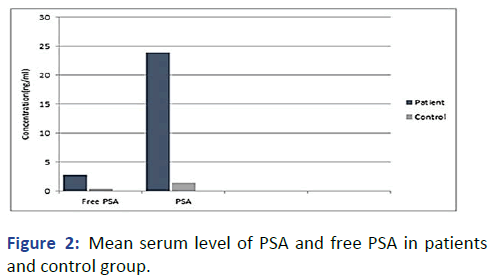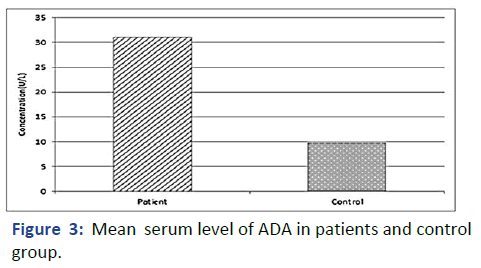Research Article - (2023) Volume 9, Issue 5
Evaluation of Adenosine deaminase (ADA) level in serum of patients with prostate cancer
Reza Saghiri*
Department of Biochemistry, Pasteur Institute of Iran, Tehran, Iran
*Correspondence:
Reza Saghiri, Department of Biochemistry, Pasteur Institute of Iran, Tehran,
Iran,
Email:
Received: 01-Mar-2023, Manuscript No. IPBMBJ-23-15801;
Editor assigned: 03-Mar-2023, Pre QC No. IPBMBJ-23-15801 (PQ);
Reviewed: 17-Mar-2023, QC No. IPBMBJ-23-15801;
Revised: 23-Oct-2023, Manuscript No. IPBMBJ-23-15801 (R);
Published:
30-Oct-2023, DOI: 10.36648/2471-8084.9.5.50
Abstract
Aim: Prostate cancer is a developing cancer in prostate gland. It is one of the common cancers among men. This cancer usually develops slowly but sometimes it is metastatic form. Screening of prostate cancer is done by measuring the PSA level, but it sometimes leads to over diagnosis in some cases. Therefore, finding another factor except PSA, for screening the cancer seems necessary. Elevation in the level of ADA is observed in some diseases like cancers. It is considered that measuring ADA level beside PSA level could be a helpful factor for screening prostate cancer.
Methods: In this study, blood sample were collected from 40 patients and 40 control participants matched for age. PSA, free PSA and ADA levels were compared in the serum of both groups. PSA assessment was based on sandwich ELISA although ADA level was measured by colorimetric methods. SPSS software was used for analyzing data.
Results: According to obtained data from patient and control groups the mean of PSA level was 23.9 ± 11.96 ng/ml and 1.33 ± 0.61 ng/ml, respectively which showed a significant increase in patients (P<0.05). ADA level was 30.99 ± 0.99 U/L and 9.8 ± 0.8 U/L in patient and control groups. It is significantly higher in patients than controls (P<0.05).
Conclusion: The study results showed a significant elevation in PSA and ADA levels in prostate cancer patients compared with control group. Therefore, serum ADA and PSA levels might be useful indexes in screening and monitoring of prostate cancer.
Keywords
Prostate cancer; Prostate specific antigen; Adenosine deaminase; Screening
Introduction
Prostate Cancer (PC) is a very common cancer among men
[1,2]. It is located in the fifth place in cancers leading death in
most countries and its prevalence is increasing annually [3-5].
Prostate cancer is usually diagnosed in 55 to 74 years old men
and its incidence is higher in African American than other
races [6,7]. It is not clear why this cancer arises, but there are
some risk factors including age which is the most important
one, race, genetics, diet and etc. that are related to this cancer
[8,9]. The mortality rates of prostate cancer is low and most of
men diagnosed with prostate cancer die of other reasons
except this cancer. Prostate cancer is asymptomatic in many
cases because its progression is very slowly [10]. Measuring
Prostate-Specific Antigen (PSA) level is a screening method for
identifying different kinds of prostate cancer [11].
PSA screening is a helpful way to diagnose prostate cancer at
early stages and employ useful treatments to cure the
disease but PSA level increases not only in prostate cancer but
also in some other conditions like prostate inflammation
and benign prostate enlargement [12-15]. Therefore, it cannot
be a good marker for screening prostate cancer on its own
and other tools should be used to aid in diagnosing the
cancer more efficiently. Biopsy is one of the methods which
is used for ensuring of exact diagnosis of prostate cancer
but because of invasiveness and some possible side effects, it
is preferred to make sure completely before using it for the
final detection [16,17].
MRI is another way that is applied in some centers for
evaluating patients.
Biological molecules like some enzymes, surface antigens and
etc., may change in some pathological conditions and
measuring them can be useful in screening and diagnosing of
some diseases.
Adenosine Deaminase (ADA) is an enzyme which contributes
in purine metabolism and catalyzes adenosine and
deoxyadenosine and delaminates them to inosine and
deoxyinosine [18,19]. These produced molecules have effects
on different cells [20]. Adenosine which modulates cell
function by adenosine receptor is regulated by ADA. The roles
of adenosine in tumor progression have been described in
some studies. Different blood cells like lymphocytes,
mononuclear cells, neutrophils and red blood cells secret this
enzyme, so it can be found in human serum. It is also
expressed on various cells and tissues. ADA has an important
role in differentiating and proliferating of T cells which are
responsible for cellular immunity. The cellular immune
response can be stimulated in different immune conditions like
infectious diseases and cancers. Therefore, the activity of this
enzyme in different body fluids can be associated with various
diseases. Increased level of serum ADA activity is observed in
diverse diseases like liver diseases, tuberculosis and some
kinds of cancer such as breast cancer. So ADA can be
considered as an auxiliary diagnostic marker in some diseases.
In this study we have measured the level of ADA in serum of
patients with prostate cancer to show the relationship
between this marker and the cancer. We are trying to find
some markers for better screening of prostate cancer to help
the patients to be safe from unnecessary treatment and also
late diagnosis.
Materials and Methods
Patients
This study was performed from April 2015 to March 2016. The
specimens were obtained from men who were referred
to Imam Hossein hospital and Pasteur institute. 40 men
who were diagnosed with prostate cancer and 40 healthy
men as control group were enrolled in the study and the same
factors were assessed in both groups. The average age in
test and control group was 77.1 ± 4.41 and 71.6 ± 6.4
respectively (Figure 1).

Figure 1: Mean age of participants in the control and patient
groups.
According to the inclusion criteria, patients with PSA level
equal or more than 10 ng/ml were participated in the study.
We received consent from participants.
Assays
3 ml of blood was collected from each patients and healthy
controls without any previous preparation. The serum was
separated based on the following protocol:
The sample remained in room temperature for 30 minutes
then it was centrifuged at 1200 g for 10 minutes. Finally, the
serum was collected and stored at -70°C for future assays.
PSA was assayed by Pishtaz kit which was based on sandwich
ELISA. The normal range of PSA is ≤ 4 ng/ml in men.
ADA was measured by ADA assay kit (Diazyme kit, USA) based
on colorimetric method. The intensity of produced color has a
direct relationship with the amount of ADA in the sample. If
its level is less than 15 U/L, it is considered normal in serum.
Statistical Analyses
We showed the data as mean ± SD and determined the
differences between control and patients group by t test. If
the P value was less than 0.05 it would be considered
significant.
Results
Comparison of obtained data from test and control group
showed that the average levels of PSA in patients and healthy
control were 23.9 ± 11.96 ng/ml and 1.33 ± 0.61 ng/ml. The
mean of free PSA level in prostate cancer patients was 2.69 ±
0.99 ng/ml and it was 0.33 ± 015 ng/ml in control group.
Comparing data between test and reference group showed a
significant increase in patients than control. (Figure 2) ADA
level has a mean of 30.99 ± 0.99 U/L and 9.8 ± 0.8 U/L in
patient and reference group, respectively which showed a
statistically significant difference between two groups. (P<0.05) (Figure 3 and Table 1).

Figure 2: Mean serum level of PSA and free PSA in patients
and control group.

Figure 3: Mean serum level of ADA in patients and control
group.
| Variable |
Control group (n=40) Mean (SEM) |
Patient group (n=40) Mean (SEM) |
P Value |
| PSA (normal range = ≤ 4 ng/ml) |
1.33 (0.66) |
23.9 (0.18) |
< 0.05 |
| Free PSA |
0.33 |
2.69 |
< 0.05 |
| ADA (normal range = <15 U/L) |
9.8 (0.39) |
30.99 (0.46) |
< 0.05 |
| (P < 0.05) |
Table 1: The mean and standard error of mean of PSA, free PSA and ADA in controls and patients with prostate cancer.
The correlation between data (PSA and age, ADA and
age, PSA and ADA) in patient and control groups was evaluated by Pearson correlation test. The results are
presented in Tables 2-4.
| Age and PSA |
Correlation |
P value |
| Control group |
0.169 |
0.296 |
| Patient group |
0.32 |
0.544 |
Table 2: The correlation coefficient between age and PSA in study groups.
| Age and ADA |
Correlation |
P value |
| Control group |
-0.105 |
0.519 |
| Patient group |
0.244 |
0.129 |
Table 3: The correlation coefficient between age and ADA in study groups.
As shown in Tables 2 and 3 no significant was observed
between age and PSA or age and ADA in patient or control groups. Although, Table 4 demonstrated a weak positive
correlation between PSA and ADA among the study groups.
| PSA and ADA |
Correlation |
P value |
| Control group |
0.377* |
0.033 |
| Patient group |
0.610* |
0 |
| *= Significant |
Table 4: The correlation coefficient between ADA and PSA in study groups.
Discussion
PSA level has been a major marker for screening prostate
cancer for a long time. Although the screening of PSA causes
reduction in risk of prostate cancer mortality, it may result
false positive in some cases which would lead to some
complicated diagnostic criteria. According to growing
incidence of prostate cancer, it seems to be necessary to find
some other markers for screening the disease to help for
accurate diagnosis. ADA is an enzyme which changes its level
has been reported in some diseases. In our study, we
measured the ADA and PSA level in patients with prostate
cancer which showed that in all cases with increased level of
PSA, an elevated level of ADA can be seen which is statistically
significant. This result might be due to leakage of ADA enzyme
from prostatic tumors [19]. Also another explanation for the
elevation in ADA level in cancers is due to increase in
production of adenosine in cancerous tissues which is the
substrate of ADA. Because of higher metabolism of
nucleotide, the level of ADA will increase too. It is also
suggested that ADA level increases to neutralize toxic effects
of elevated adenosine level, Most of the studies on ADA have
considered the importance of the level and role of ADA in
tuberculosis. A lot of researches have evaluated ADA level in
different cancers, but there are some controversial results in
these studies. For example, Dasmahapatra, et al., believed that ADA level in lymphocyte decreases in patients with head
and neck cancer and in 1985 Kojima and colleagues also
showed the same result in patients with gastric cancer. These
results may be an indicator of the suppression of cell
mediated immunity in cancers. Elevation in ADA level in
patients with different kinds of cancer has also been reported
in other studies. In 2010, Aghai and colleagues indicated the
level of ADA increased in serum of breast cancer patients. A
study by Pirincci group in 2012 on patients with bladder
cancer showed higher level of ADA in patient’s serum than in
references. In the same year, Mahajan, et al., found that ADA
level increased in breast cancer patients and it decreased
after treatment. In 2016, Pirincci group also showed that the
level of ADA was increased in patients with renal cell
carcinoma and it might be an additional biomarker for RCC
diagnosis. Another study in 2016 which was done by Ghaderi,
et al. assessed the level of ADA activity in serum of CLL
patients and showed its elevation in patients. Therefore,
according to the results of these studies increase in ADA level
can be seen in various cancers. These results are compatible
with the result that we have obtained in our research. A few
studies have assessed the serum level of ADA in prostate
cancer patients in Iran and other countries. Our study is the
first research in Iran for evaluating the ADA level in prostate
cancer cases. In our research we found two other studies that
had measured ADA level in prostate cancer patients and as a
result decrease in the level of ADA was observed in patients
compared to control in them which is against our result. Since
our study is the first research in Iran for evaluating the ADA
level in prostate cancer cases and according to the existing
contradictions further research seems to be necessary. Based
on the results of our study, ADA level in serum might be
potentially a useful index in screening of prostate cancer.
However, because its elevation is also observed in other
cancers, it is better to use both PSA and ADA level for the
screening. PSA and ADA also can be useful in follow up the
patients after treatment. They can prevent patients from
unnecessary diagnostic criteria like biopsy. Owing to the
limited number of studies on ADA and prostate, It seems that
conducting further research with larger number of
participants could bring about more precise results. It is a
good suggestion to try to find a relationship between PSA and
ADA level that could be applied in accurate diagnosis or
finding some other biological markers that their elevation is
only specific for prostate cancer [21,22].
Conclusion
The study results showed a significant elevation in PSA and
ADA levels in prostate cancer patients compared with control
group. Therefore, serum ADA and PSA levels might be useful
indexes in screening and monitoring of prostate cancer.
References
- Fitzmaurice C, Dicker D, Pain A (2015) Global burden of disease cancer collaboration. JAMA Oncol. 1:505-527.
[Crossref] [Google Scholar] [PubMed]
- Yedjou CG, Mbemi AT, Noubissi F (2019) Prostate cancer disparity, chemoprevention, and treatment by specific medicinal plants. Nutrients. 11(12):336-353.
[Crossref] [Google Scholar] [PubMed]
- Dunn MW (2017) Prostate cancer screening. Semin Oncol Nurs. 33:156-164.
[Crossref] [Google Scholar] [PubMed]
- Ilic D, Djulbegovic M, Jung JH (2018) Prostate cancer screening with Prostate-Specific Antigen (PSA) test: A systematic review and meta-analysis. BMJ. 362:k3519.
[Crossref] [Google Scholar] [PubMed]
- Fenton JJ, Weyrich MS, Durbin S (2018) Prostate specific antigen based screening for prostate cancer: Evidence report and systematic review for the US preventive services task force. JAMA. 319(18):1914-1931.
[Google Scholar] [PubMed]
- Jones RA, Underwood SM, Rivers BM (2007) Reducing prostate cancer morbidity and mortality in African American men: issues and challenges. Clin J Oncol Nurs. 11:865-872.
[Crossref] [Google Scholar] [PubMed]
- Auprich M, Bjartell A, Chun FK-H (2011) Contemporary role of prostate cancer antigen 3 in the management of prostate cancer. Eur Urol. 60:1045-54.
[Crossref] [Google Scholar] [PubMed]
- Bul M, van Leeuwen PJ, Zhu X (2011) Prostate cancer incidence and disease specific survival of men with initial prostate specific antigen less than 3.0 ng/ml who are participating in ERSPC Rotterdam. Eur Urol. 59:498-505.
[Crossref] [Google Scholar] [PubMed]
- Lin K, Lipsitz R, Miller T (2008) Benefits and harms of prostate specific antigen screening for prostate cancer: An evidence update for the US preventive services task force. Ann Intern Med. 149:192-199.
[Crossref] [Google Scholar] [PubMed]
- Vickers AJ (2017) Prostate cancer screening: Time to question how to optimize the ratio of benefits and harms. Ann Intern Med. 167:509-510.
[Crossref] [Google Scholar] [PubMed]
- Bul M, Zhu X, Rannikko A (2012) Radical prostatectomy for low risk prostate cancer following initial active surveillance: results from a prospective observational study. Eur Urol. 62:195-200.
[Crossref] [Google Scholar] [PubMed]
- Jakupsstovu Jo, Brodersen J (2018) Do men with lower urinary tract symptoms have an increased risk of advanced prostate cancer? BMJ. 361:k1202.
[Crossref] [Google Scholar] [PubMed]
- Tikkinen KA, Dahm P, Lytvyn L (2018) Prostate cancer screening with Prostate Specific Antigen (PSA) test: A clinical practice guideline. BMJ. 362:k3581.
[Crossref] [Google Scholar] [PubMed]
- Lupicka-Slowik A, Grzywa R, Leporowska (2019) Development and evaluation of an immunoglobulin Y based ELISA for measuring prostate specific antigen in human serum. Ann Lab Med. 39:373-380.
[Crossref] [Google Scholar] [PubMed]
- Ungerer JP, Oosthuizen HM, Bissbort SH (1992) Serum adenosine deaminase: Isoenzymes and diagnostic application. Clin Chem. 38:1322-1326.
[Crossref] [Google Scholar] [PubMed]
- Pirincci N, Kaya TY, Kaba M (2017) Serum adenosine deaminase, catalase, and carbonic anhydrase activities in patients with renal cell carcinoma. Redox Rep. 22:252-256.
[Crossref] [Google Scholar] [PubMed]
- Gakis C (1996) Adenosine Deaminase (ADA) isoenzymes ADA1 and ADA2: Diagnostic and biological role. Eur Respir J. 9(4):632-633.
[Crossref] [Google Scholar] [PubMed]
- Kutryb-Zajac B, Koszalka P, Mierzejewska P (2018) Adenosine deaminase inhibition suppresses progression of 4T1 murine breast cancer by adenosine receptor dependent mechanisms. J Cell Mol Med. 22:5939-5954.
[Crossref] [Google Scholar] [PubMed]
- Verma A, Abisheganaden J, Light RW (2016) Identifying malignant pleural effusion by a cancer ratio (serum LDH: Pleural fluid ADA ratio). Lung. 194:147-153.
[Crossref] [Google Scholar] [PubMed]
- Yegutkin GG (2014) Enzymes involved in metabolism of extracellular nucleotides and nucleosides: Functional implications and measurement of activities. Crit Rev Biochem Mol Biol. 49:473-497.
[Crossref] [Google Scholar] [PubMed]
- Pirincci N, Gecit I, Gunes M (2012) Serum adenosine deaminase, catalase and carbonic anhydrase activities in patients with bladder cancer. Clinics. 67:1443-1446.
[Crossref] [Google Scholar] [PubMed]
- Salmanzadeh S, Tavakkol H, Bavieh K (2015) Diagnostic value of serum Adenosine Deaminase (ADA) level for pulmonary tuberculosis. Jundishapur J Microbiol. 8(3):e21760.
[Crossref] [Google Scholar] [PubMed]
Citation: Saghiri R (2023) Evaluation of Adenosine Deaminase (ADA) Level in Serum of Patients with Prostate Cancer. Biochem Mol Biol J. 9:021.
Copyright: © 2023 Saghiri R. This is an open-access article distributed under the terms of the Creative Commons Attribution License, which permits unrestricted use, distribution, and reproduction in any medium, provided the original author and source are credited.




